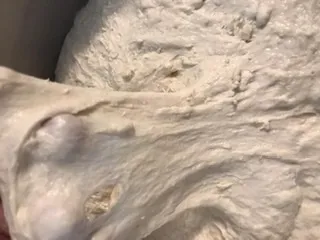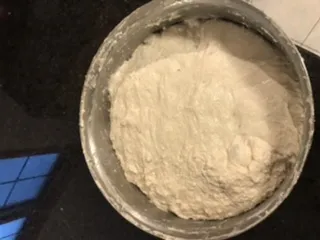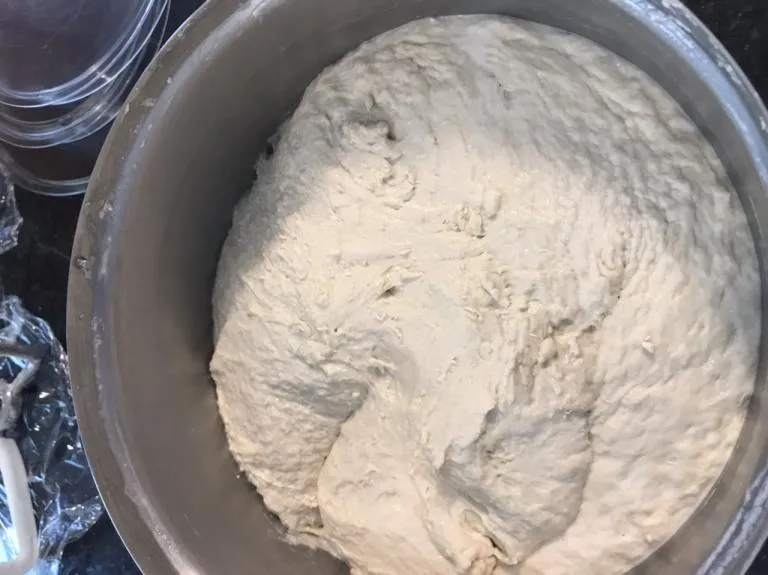


Mix long. Mix short. Autolyse or not. Add starter / salt separately or mix salt with flour and then water and starter together. Makes no difference.
I’m using a Bosch Universal (from the 90s) and I’m getting really tired of wasting flour.
My formula is 375g ripe levain (3 builds starting with 25g each - starter / water / flour). 2245g (total) flour. Whatever amount of (total) water depending on desired hydration level.
I’m trying to attain maximum gluten DEVELOPMENT. What in the world am I missing?? What is going on here?
Please please please HELP!
Why does my Bosch Universal keep producing this??
Image
Image
Image
It could be the water. Water hardness or mineral content or lack there of could be the problem.
Bosch I get a decent dough just not advanced gluten development.....
???
Hi Ben,
I looked into it again today and it seems that due to the mechanism of mixing in that mixer, the shaggy look is to be expected! Even when the gluten is well developed! :)
You first knead it for 5-30 min on 1st speed, then let it rest for 15-20 min and only then you will be able to test it by windowpanning and to see the degree of gluten development.
Even after 25 min of kneading on 1st speed it doesn't give you a smooth look. A batch of dough made with 800 g of flour (Italian bread flour type 00 here) it looks definitely shaggy.
Shape it into a ball and let it rest for a few min. You will be able to see the "veins" on the surface. These are strands of gluten - a sign that the dough is well kneaded.
After 20 min rest, you can test it for windowpanning, for the degree of gluten development
And if you are happy with it, then let the dough rise/ferment. If not, then knead longer, rest and test again.
5 min kneading and then rest to test for the minimal gluten development
Ten min of kneading, shaggy
I.e. it will always come out shaggy, because it rips the dough with its two hooks as it develops gluten. You need to give it a rest for the strands of gluten to link together, to see the true state of gluten.
Discussion and images: https://www.pizzamaking.com/forum/index.php?topic=11962.0
There are methods of hand kneading that also develop gluten by ripping it, ending up with a well developed shaggy mass. It's a very ancient French method still taught in France today. For example, starting at 2:22 this master baker, the founder of the Bread Baker's Guild of America shows with his hands what your mixer does with two hooks:
s
See how terribly shaggy it looks at the end of kneading, when it is kneaded to gluten development and then shaped into a ball:
You never disappoint! So it needs to be rested to be able to be tested. :)
Does it need a 25 minute rest each time that it gets kneaded some more?
If it's so difficult to tell because it's always so shaggy, how can I ever know how far along I am without having to let it rest first for an extended period of time?
Exactly! Rest it then test it 😂
Ben, you need only one test, just like I did only one test in my food processor to determine how it develops gluten. After that I knew the timing. Never had to determine it each time for different doughs individually.
So dedicate about two lbs of flour (because you usually mix larger batches and because this mixer does not knead tiny amounts of dough) and 30-60 min of your time once and you will know.
Mix 1000g of flour and water to obtain dough of medium consistency which you usually aim at (600-700g water?) Let it rest for 20min to hydrate the flour particles. Turn on first speed and knead for ten min. Chop off a 3oz piece of dough, make it into a ball and set it aside, covered, refrigerated, continue kneading the remainder for ten min longer. Repeat the process of chopping off a piece and kneading the remainder for ten min longer.
So you will end up with two small balls of dough and one large one which will rest for 20 min each, minimum. After that check for the degree of gluten development in each by windowpanning to the breaking point and by stretching a ball into a flat piece and folding it 3x3 and tucking it into a ball to see the bubbles on its surface, their number, their sizes, their translucency. Then you will know what 10-20-30 min of kneading on first speed does to your dough and its gluten.
It would be nice to continue with this process until you reach the point of gluten breakdown, destroying your dough by overmixing it as I did in my food processor experiment, but for your purposes it is not necessary.
This is what a 60% hydration dough looks like after kneading it for 8min on first in Bosch Universal and 20 min rest. This is the initial stage of gluten development. Minimally developed gluten, as needed for baguettes or pizzas, the equivalent of about 600-800 turns if kneaded by hand.
https://www.pizzamaking.com/forum/index.php?topic=11900.0
This plain dough that you mixed in your kneading experiment could be later used to feed your starter, make a levain or a bread dough once you add to it water, salt, starter or yeast, more flour according to the recipe etc. Whatever is needed. It can be used immediately or refrigerated for up to 5 days.
Thank you! Thank you!
Back to homework yet again. :)
Thanks for sticking to it in helping me get to the bottom of this!
It was really driving me crazy!
You are welcome, Ben. It seems that your metal bowl also matters. In a plastic bowl kneading proceeds differently. There was a discussion about it here
Question
Answer
Reply with feedback
I do not own a Bosch Universal, so I cannot help by sharing my own experience with it. My smaller Bosh will develop gluten in 4-5 min but only on maximum speed, the same speed that you'd use to whip egg whites or cream. So I doubt that Bosch Universal will develop gluten in 4-5 min on first speed. I will be waiting for hour results.
I hope your experiments will disclose what is going on!
Thank you again! I did consider the different bowls possibly being the cause of the problem so I did already give that a try. I got the same results in both so I do not believe that that is where the issue lies.
I think you are up to something with the method of ripping the dough that the Bosch uses. I also think that much of the discussion about the gluten develops in the Bosch (5-10 minutes absolute max.) is what people find in yeasted breads. (I know you will hammer me for suggesting that because you’ve always maintained that gluten is gluten- period but I really believe (just from experience) that they behave differently and develop differently - unless the difference is due to my yeasted south’s being enriched while my sourdough doughs are lean? Possibly the enriched south’s develop more quickly?)
Now I have some really good homework assignments to do. ;). The thing that’s leads me to believe that your first theory is correct is the fact that the same with that I could not get set up properly with the Bosch I had no problem getting full development with it in the food processor if you remember….
Will keep you posted.